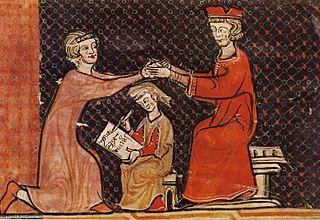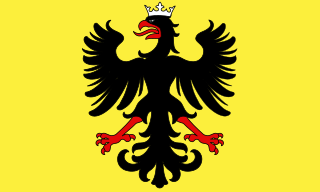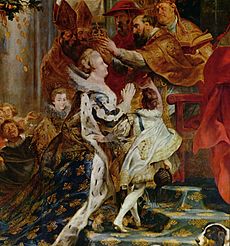
Feudalism, also known as the feudal system, was a combination of legal, economic, military, cultural, and political customs that flourished in medieval Europe between the 9th and 15th centuries. Broadly defined, it was a way of structuring society around relationships derived from the holding of land in exchange for service or labour.

An oath of fealty, from the Latin fidelitas (faithfulness), is a pledge of allegiance of one person to another.

A fief was a central element in medieval contracts based on feudal law. It consisted of a form of property holding or other rights granted by an overlord to a vassal, who held it in fealty or "in fee" in return for a form of feudal allegiance, services, and/or payments. The fees were often lands, land revenue or revenue-producing real property like a watermill, held in feudal land tenure: these are typically known as fiefs or fiefdoms. However, not only land but anything of value could be held in fee, including governmental office, rights of exploitation such as hunting, fishing or felling trees, monopolies in trade, money rents and tax farms. There never existed a standard feudal system, nor did there exist only one type of fief. Over the ages, depending on the region, there was a broad variety of customs using the same basic legal principles in many variations.

The Investiture Controversy or Investiture Contest was a conflict between the Church and the state in medieval Europe over the ability to choose and install bishops (investiture) and abbots of monasteries and the pope himself. A series of popes in the 11th and 12th centuries undercut the power of the Holy Roman Emperor and other European monarchies, and the controversy led to nearly 50 years of conflict.

A vassal or liege subject is a person regarded as having a mutual obligation to a lord or monarch, in the context of the feudal system in medieval Europe. While the subordinate party is called a vassal, the dominant party is called a suzerain. The rights and obligations of a vassal are called vassalage, while the rights and obligations of a suzerain are called suzerainty. The obligations of a vassal often included military support by knights in exchange for certain privileges, usually including land held as a tenant or fief. The term is also applied to similar arrangements in other feudal societies.

A gokenin (御家人) was initially a vassal of the shogunate of the Kamakura and the Muromachi periods. In exchange for protection and the right to become jitō, a gokenin had in times of peace the duty to protect the imperial court and Kamakura. In times of war, he had to fight with his forces under the shōgun’s flag. From the mid-13th century, the fact that gokenin were allowed to become de facto owners of the land they administered, coupled to the custom that all gokenin children could inherit, brought the parcelization of the land and a consequent weakening of the shogunate. The gokenin class ceased to be a significant force during the Muromachi period and was supplanted by the figure of the daimyō. During the successive Edo period, the term finally came to indicate a direct vassal of the shōgun, below an omemie (御目見), meaning that they did not have the right to an audience with the shōgun.
Examples of feudalism are helpful to fully understand feudalism and feudal society. Feudalism was practiced in many different ways, depending on location and period, thus a high-level encompassing conceptual definition does not always provide a reader with the intimate understanding that detailed historical examples provide.

In medieval and early modern Europe, a tenant-in-chief was a person who held his lands under various forms of feudal land tenure directly from the king or territorial prince to whom he did homage, as opposed to holding them from another nobleman or senior member of the clergy. The tenure was one which denoted great honour, but also carried heavy responsibilities. The tenants-in-chief were originally responsible for providing knights and soldiers for the king's feudal army.
Investiture is a formal installation or ceremony that a person undergoes, often related to membership in Christian religious institutes as well as Christian knighthoods or damehoods, in addition to government offices.
A lordship is a territory held by a lord. It was a landed estate that served as the lowest administrative and judicial unit in rural areas. It originated as a unit under the feudal system during the Middle Ages. In a lordship, the functions of economic and legal management are assigned to a lord, who, at the same time, is not endowed with indispensable rights and duties of the sovereign. Lordship in its essence is clearly different from the fief and, along with the allod, is one of the ways to exercise the right.
Fondo Protonotaro is a collection of documents at the state Archive of Palermo, in which are registered, among other records, all the acts pertaining to baronies and other feudal properties in Sicily before the abolition of feudalism in 1812. This was consistent with feudal law which requires at the death of a vassal or lord the feudal investiture of his successor. Acting for the Crown, the High Notary also undertook investiture upon a subject's purchase of a manor. As in other realms, in the Kingdom of Sicily feudal investiture was based on a pledge of homage and fealty. These are primary sources, and the nearest thing to a complete record or list of Sicily's feudal nobility.

Homage in the Middle Ages was the ceremony in which a feudal tenant or vassal pledged reverence and submission to his feudal lord, receiving in exchange the symbolic title to his new position (investiture). It was a symbolic acknowledgement to the lord that the vassal was, literally, his man (homme). The oath known as "fealty" implied lesser obligations than did "homage". Further, one could swear "fealty" to many different overlords with respect to different land holdings, but "homage" could only be performed to a single liege, as one could not be "his man" to more than one "liege lord".

A heerlijkheid was a landed estate that served as the lowest administrative and judicial unit in rural areas in the Dutch-speaking Low Countries before 1800. It originated as a unit of lordship under the feudal system during the Middle Ages. The English equivalents are manor, seigniory and lordship. The German equivalent is Herrschaft. The heerlijkheid system was the Dutch version of manorialism that prevailed in the Low Countries and was the precursor to the modern municipality system in the Netherlands and Flemish Belgium.

In the feudal system of the European Middle Ages, an ecclesiastical fief, held from the Catholic Church, followed all the laws laid down for temporal fiefs. The suzerain, e.g. bishop, abbot, or other possessor, granted an estate in perpetuity to a person, who thereby became his vassal.

Georgian feudalism, or patronkmoba, as the system of personal dependence or vassalage in ancient and medieval Georgia is referred to, arose from a tribal-dynastic organization of society upon which was imposed, by royal authority, an official hierarchy of regional governors, local officials and subordinates. It is thought to have its roots into the ancient Georgian, or Iberian, society of Hellenistic period.

The Holy Roman Emperor received the imperial regalia from the hands of the pope, symbolizing both the pope's right to crown Christian sovereigns and also the emperor's role as protector of the Roman Catholic Church. The Holy Roman empresses were crowned as well.

Feudalism as practiced in the Kingdoms of England during the medieval period was a state of human society that organized political and military leadership and force around a stratified formal structure based on land tenure. As a military defence and socio-economic paradigm designed to direct the wealth of the land to the king while it levied military troops to his causes, feudal society was ordered around relationships derived from the holding of land. Such landholdings are termed fiefdoms, traders, fiefs, or fees.
Feudalism in the Holy Roman Empire was a politico-economic system of relationships between liege lords and enfeoffed vassals that formed the basis of the social structure within the Holy Roman Empire during the High Middle Ages. In Germany the system is variously referred to Lehnswesen, Feudalwesen or Benefizialwesen.
Love service is a ritualized form of male love-devotion toward women, especially noble women, that was popularized in the Middle Ages.

The Principality of Tarragona was a state that existed in and around the city of Tarragona on the northeastern side of the Iberian peninsula from its founding by the Norman adventurer Robert d'Aguilo I in 1129 until its ultimate absorption into the Crown of Aragon in the 1170s following two decades of civil war. The state was founded after the permanent conquest of Tarragona by Christian forces during the Reconquista in 1128.













